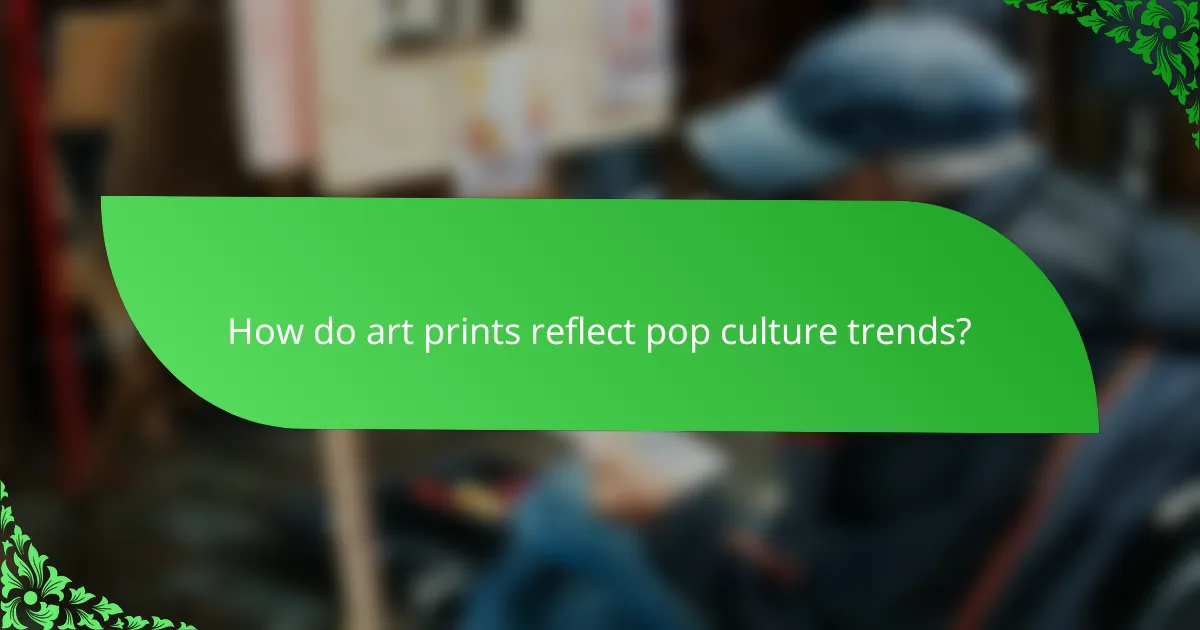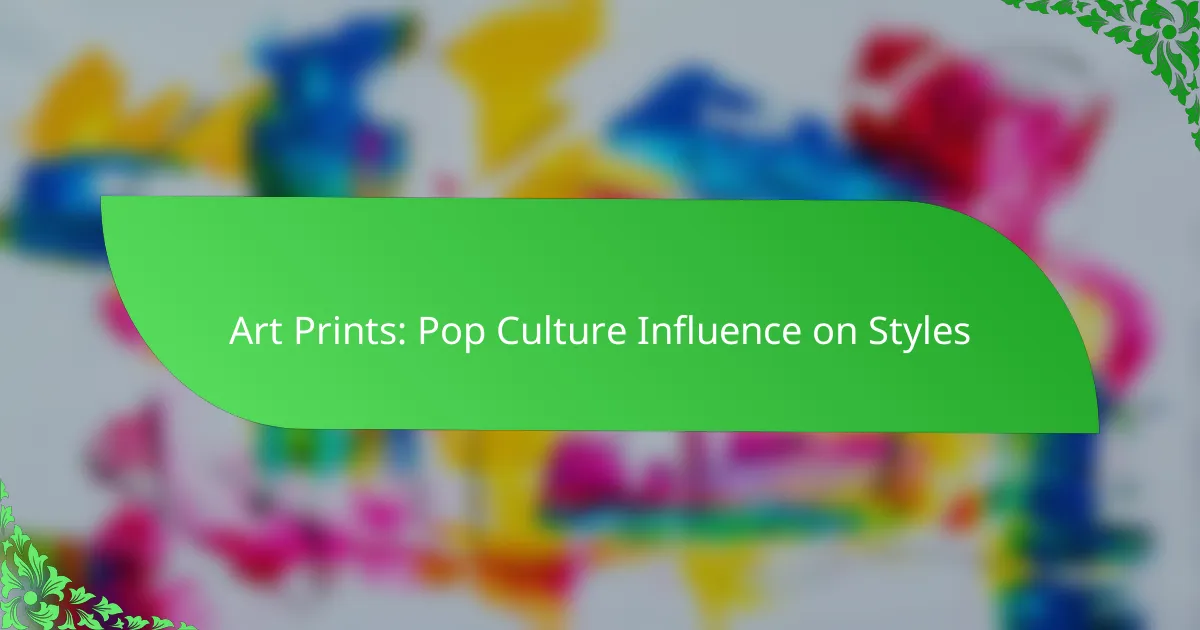Art prints serve as a vibrant reflection of pop culture, intertwining themes and imagery that resonate with today’s society. By drawing inspiration from music, movies, and social movements, these prints create a visual dialogue that is both relatable and relevant. When selecting pop culture art for your space, it’s essential to align your personal taste with the aesthetics of your environment, ensuring a harmonious blend of style and sentiment.

How do art prints reflect pop culture trends?
Art prints often mirror pop culture trends by incorporating themes, styles, and imagery that resonate with contemporary society. This connection allows artists to engage with audiences on familiar grounds, making their work more relatable and relevant.
Influence of movies on art styles
Movies have a significant impact on art styles, often inspiring visual artists to adopt cinematic themes and aesthetics. For example, the vibrant colors and dramatic compositions found in films can translate into striking art prints that capture the essence of popular narratives.
Artists may also draw inspiration from iconic scenes, characters, or quotes, creating prints that celebrate or critique cinematic culture. This interplay between film and art not only enhances the visual appeal but also invites viewers to explore deeper meanings.
Impact of music on visual art
Music influences visual art by shaping the emotional and thematic elements that artists choose to express. Album covers, for instance, often serve as a canvas for artistic experimentation, reflecting the genre and mood of the music within.
Moreover, artists may create prints inspired by lyrics or the overall vibe of a song, using colors and forms that evoke the same feelings as the music. This synergy between sound and sight fosters a unique cultural dialogue that resonates with fans of both mediums.
Television shows shaping artistic themes
Television shows play a crucial role in shaping artistic themes, often introducing narratives and characters that inspire artists. Popular series can lead to a surge in art prints that depict beloved characters or iconic moments, tapping into the collective nostalgia of viewers.
Additionally, the visual style of a show, such as its color palette or set design, can influence artists to create prints that echo these elements. This connection between television and art not only reflects current trends but also allows artists to comment on societal issues presented in these shows.

What are popular pop culture art print styles?
Popular pop culture art print styles reflect contemporary trends and cultural phenomena, often drawing inspiration from music, movies, and social movements. These styles can vary widely, but they typically emphasize bold visuals, nostalgia, and accessibility.
Retro and vintage styles
Retro and vintage styles in pop culture art prints often evoke nostalgia by referencing past decades, particularly the 60s, 70s, and 80s. These prints frequently feature iconic imagery, color palettes, and typography that resonate with those who experienced these eras firsthand.
When selecting retro art prints, consider the emotional connection they may foster. Look for prints that incorporate familiar symbols, such as classic movie posters or vintage advertisements, to create a sense of warmth and familiarity in your space.
Minimalist pop art
Minimalist pop art strips down complex ideas into simple, striking visuals, often using bold colors and clean lines. This style emphasizes clarity and impact, making it an appealing choice for modern interiors that prioritize simplicity and functionality.
To effectively use minimalist pop art, focus on pieces that convey a strong message or concept with minimal elements. This approach can enhance the aesthetic of a room without overwhelming the viewer, creating a balanced and thoughtful environment.
Street art influences
Street art influences in pop culture art prints bring the vibrancy and raw energy of urban environments into homes and galleries. This style often incorporates graffiti techniques, stencils, and bold imagery, reflecting contemporary social issues and cultural commentary.
When choosing street art-inspired prints, consider their potential to provoke thought and discussion. Look for works that resonate with current events or personal beliefs, as these pieces can serve as powerful focal points in your decor.

How to choose pop culture art prints for your space?
Choosing pop culture art prints for your space involves aligning your personal taste with the aesthetics of your environment. Consider the themes and styles that resonate with you while ensuring they complement the overall decor of your room.
Consider your personal style
Your personal style is crucial when selecting pop culture art prints. Think about your favorite movies, music, or iconic figures that inspire you. This reflection will guide you toward prints that not only appeal to you but also express your individuality.
For example, if you lean towards retro aesthetics, consider prints featuring vintage movie posters or classic album covers. Alternatively, if modern minimalism is your preference, look for contemporary interpretations of pop culture icons.
Match art with room aesthetics
Matching your art prints with the aesthetics of your room creates a cohesive look. Take into account the color palette, furniture style, and overall theme of the space. For instance, vibrant prints can energize a neutral room, while monochromatic pieces may enhance a modern, sleek design.
Consider the function of the room as well. A playful print might work well in a child’s playroom, while a sophisticated piece could be more appropriate for a home office or living area.
Evaluate size and scale
Size and scale are essential factors when choosing pop culture art prints. Large prints can serve as focal points, while smaller pieces can create a gallery wall effect. Measure your wall space to determine what size will fit best without overwhelming the area.
As a general rule, aim for art that occupies about two-thirds of the wall space if it’s a single piece. For multiple prints, consider a balanced arrangement that allows for visual breathing room between each piece.

Where to buy pop culture art prints?
You can find pop culture art prints in various places, including online marketplaces, specialty art retailers, and local art fairs. Each option offers unique selections and price ranges, catering to different tastes and budgets.
Online marketplaces like Etsy
Online marketplaces such as Etsy are popular for purchasing pop culture art prints. These platforms feature a wide array of independent artists and sellers, allowing you to discover unique pieces that resonate with your interests.
When shopping on Etsy, consider checking seller reviews and ratings to ensure quality. Prices can vary significantly, often ranging from $10 to $100 or more, depending on the artist and the complexity of the print.
Specialty art retailers
Specialty art retailers often curate collections of pop culture art prints, focusing on specific themes or styles. These stores may offer limited editions or exclusive pieces that you won’t find elsewhere.
When visiting a specialty retailer, inquire about the artist’s background and the print’s production methods. Prices in these shops can range from $20 to several hundred dollars, reflecting the quality and exclusivity of the artwork.
Local art fairs and galleries
Local art fairs and galleries provide an excellent opportunity to buy pop culture art prints directly from artists. These venues often showcase emerging talent and unique pieces that capture local culture and trends.
Attending these events allows you to engage with artists and learn about their creative processes. Prices can vary widely, typically starting around $15 and going up to several hundred dollars, depending on the artist’s reputation and the print’s size.

What are the pricing factors for art prints?
The pricing of art prints is influenced by several key factors, including print quality, the artist’s reputation, and the exclusivity of the edition. Understanding these elements can help buyers make informed decisions and assess the value of a print.
Print quality and material
Print quality significantly affects the price of art prints. Higher-quality prints often use archival inks and premium materials, which enhance durability and visual appeal. Common materials include fine art paper, canvas, and metal, with prices typically ranging from a few dozen to several hundred dollars based on the quality.
When selecting a print, consider factors like color accuracy, texture, and finish. For instance, giclée prints, known for their high resolution and color fidelity, usually command higher prices than standard digital prints.
Artist reputation and demand
The reputation of the artist plays a crucial role in determining the price of their prints. Established artists with a strong following can charge significantly more than emerging artists. Prices for prints by well-known artists can range from hundreds to thousands of dollars, depending on their market demand.
Additionally, the perceived value of an artist’s work can fluctuate based on current trends in the art market. Collectors often pay a premium for prints from artists who are gaining popularity or have a unique style that resonates with audiences.
Edition size and exclusivity
Edition size refers to the number of prints produced from a single artwork, and it directly impacts pricing. Limited editions, which may consist of only a few dozen prints, tend to be more valuable than open editions, where prints are produced indefinitely. Prices for limited edition prints can be significantly higher due to their scarcity.
Exclusivity can also be enhanced through artist signatures or certificates of authenticity, which add value and assurance for collectors. When purchasing art prints, consider the edition size and whether it includes any unique features that contribute to its desirability and price.

How to care for and maintain art prints?
Caring for and maintaining art prints is essential to preserve their quality and longevity. Proper handling, storage, and display can prevent damage and fading, ensuring your prints remain vibrant for years.
Handling art prints
When handling art prints, always wear clean cotton gloves to avoid transferring oils or dirt from your hands. Hold the prints by the edges, avoiding direct contact with the image area. This minimizes the risk of smudges or scratches.
Storage tips
Store art prints in a cool, dry place away from direct sunlight to prevent fading. Use acid-free materials, such as sleeves or boxes, to protect them from moisture and dust. Flat storage is preferred, but if rolled, ensure they are stored loosely to avoid creases.
Display considerations
When displaying art prints, choose frames with UV-protective glass to shield them from harmful light. Avoid placing prints in areas with high humidity or temperature fluctuations, such as bathrooms or near heating vents. Regularly check for signs of wear or damage to address issues promptly.
